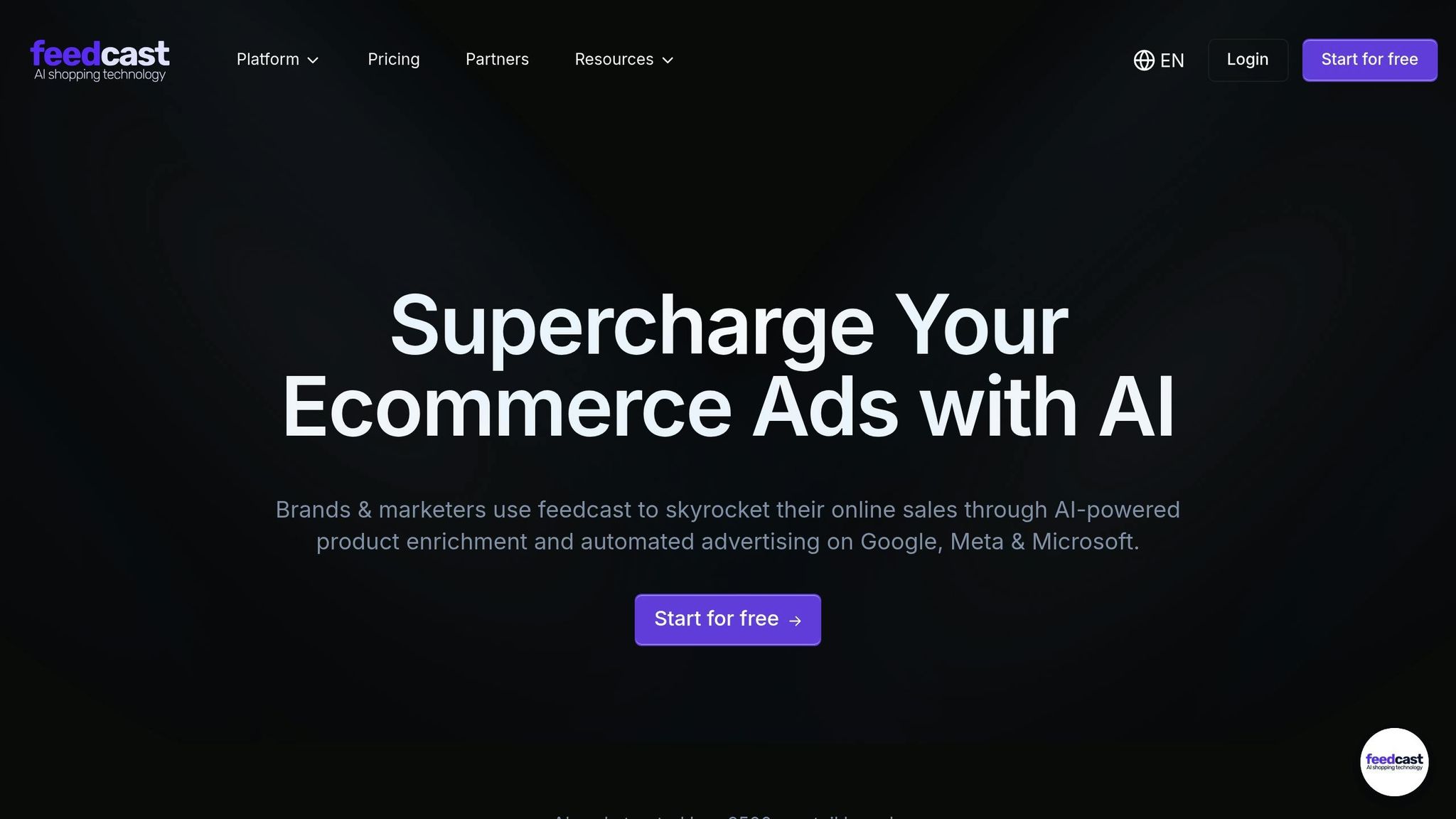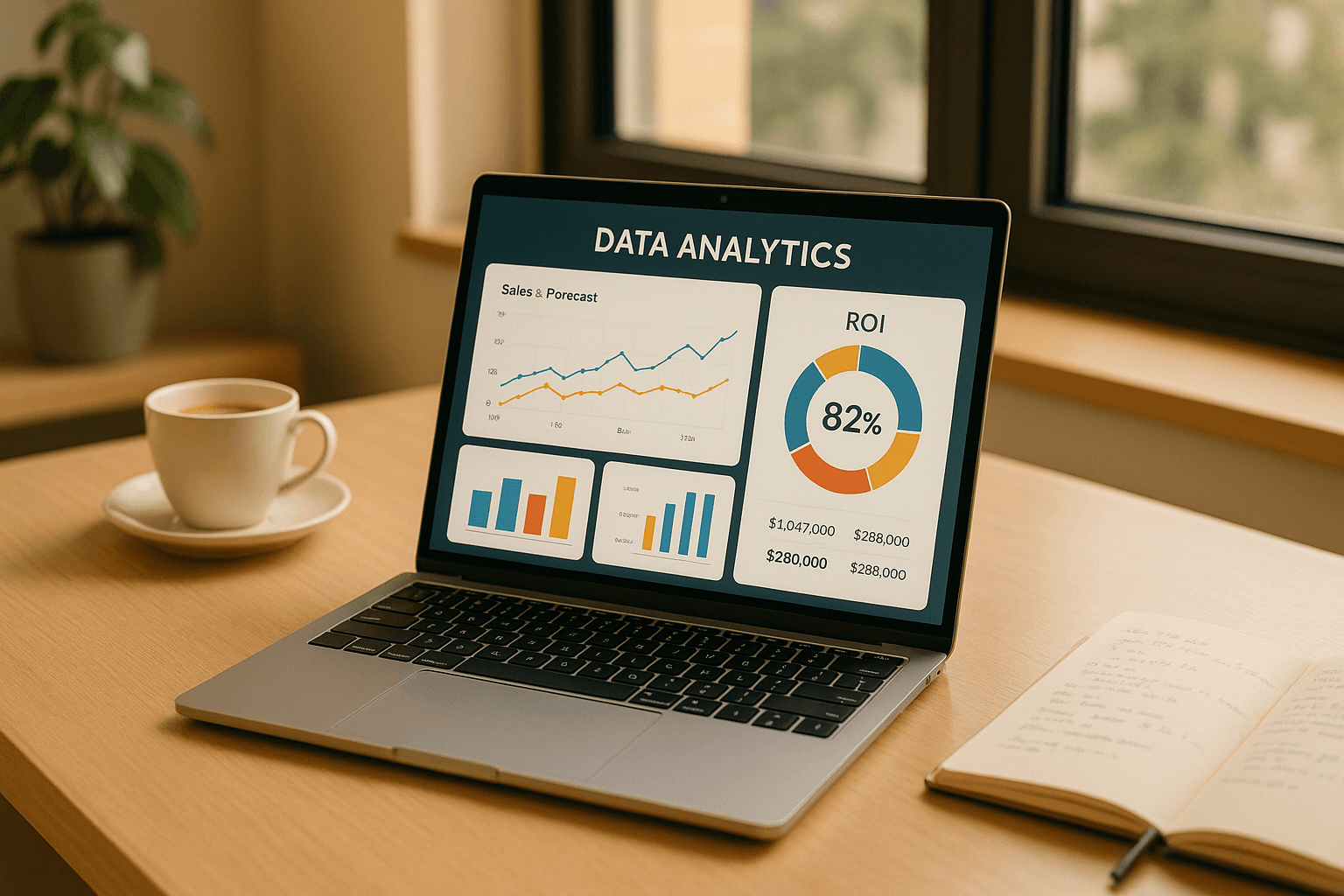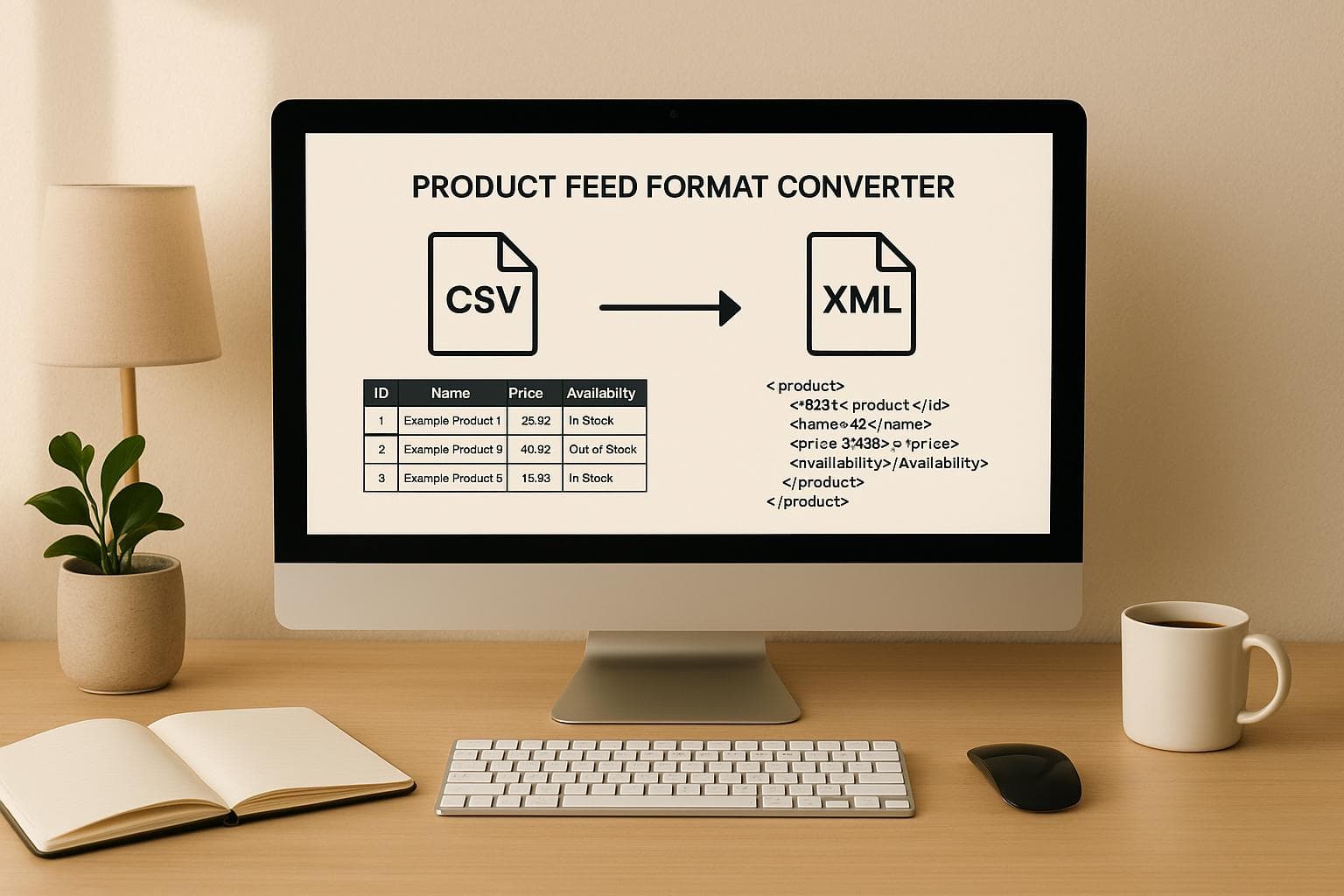How Predictive Analytics Improves ROI Forecasting
Explore how predictive analytics enhances ROI forecasting for e-commerce through improved targeting, engagement, and customer retention strategies.
Predictive analytics helps e-commerce businesses make smarter decisions by using data to forecast future trends, optimize ad spend, and improve customer retention. Companies using predictive tools can achieve:
- Up to 25% better ROI on marketing campaigns.
- 10–15% higher sales through dynamic customer segmentation.
- 20–30% increases in engagement with personalized strategies.
- Reduced churn by identifying and addressing at-risk customers.
Key benefits include better targeting, real-time adjustments, and actionable insights, all leading to more accurate ROI predictions and improved profitability. Tools like Feedcast simplify the process by automating data integration, refining campaigns, and delivering real-time analytics for businesses of all sizes.
AI for Marketing & Growth #1 - Predictive Analytics in Marketing
How Predictive Analytics Improves ROI in E-commerce
Predictive analytics takes raw data and transforms it into actionable insights, allowing businesses to make more accurate ROI predictions. Instead of relying on guesswork, companies can forecast customer behavior and campaign outcomes with precision. Here's a closer look at how predictive analytics drives measurable improvements in key areas of e-commerce.
Customer Segmentation for Better Targeting
Predictive analytics takes audience targeting to the next level. While traditional segmentation often relies on basic factors like age or location, predictive models dig deeper, analyzing customer behaviors and purchase histories to uncover profitable segments. Using machine learning, these models identify patterns that might otherwise go unnoticed.
For instance, companies leveraging predictive customer segmentation have reported up to a 300% increase in marketing ROI [3]. This success comes from creating highly focused campaigns tailored to specific customer groups, rather than generic messaging.
Take SuperAGI and ASOS as an example - they achieved a 325% ROI by identifying seven distinct customer segments based on browsing and purchase behaviors [3]. Dynamic segmentation goes even further by adapting to real-time changes in customer behavior. Unlike static demographic categories, dynamic segments evolve, helping businesses craft campaigns that can boost sales by 10–15% and improve customer satisfaction by up to 20% [3].
A Malaysian bank partnered with Xerago to implement real-time segmentation by consolidating customer data into unified profiles. By analyzing on-site behavior, location, and other factors, the bank increased engagement rates by 35% and saw a 43% improvement in application conversion rates [3]. This level of precision sets the stage for better ad campaign performance.
Ad Campaign Performance Optimization
Predictive analytics helps businesses optimize ad campaigns by forecasting which strategies will deliver the best ROI - before any budget is spent. With rising ad costs (some industries report a 15% year-over-year increase in cost-per-click [4]), this approach ensures every dollar counts.
By analyzing past campaign data, customer behaviors, and market trends, predictive models can reduce ad spend waste by as much as 30% [4]. This allows businesses to focus resources on high-performing opportunities. For example, one TruLata client reduced their cost-per-acquisition by 25% using AI-recommended ad placements, while another SaaS company saw a 15% increase in click-through rates with AI-crafted ad copy [4]. Companies using AI-driven insights also outperform competitors by 25% in customer acquisition [4].
Real-time analytics further enhances performance, enabling marketers to make quick adjustments. This shifts marketing from a reactive approach to a proactive, data-driven strategy.
Personalization and Customer Engagement
Predictive analytics also revolutionizes personalization, creating more meaningful customer interactions. It does more than just suggest products - it builds tailored experiences that align with individual preferences and behaviors, driving engagement and conversions.
With 70% of customers finding most marketing messages irrelevant, predictive analytics solves this by delivering the right message at the right time [3]. AI-powered personalization can lead to a 20–30% increase in ROI [3].
By examining data like browsing habits, purchase history, and engagement metrics, businesses can craft personalized recommendations, targeted email campaigns, and customized promotions. Companies using predictive analytics are nearly three times more likely to report significant improvements in customer satisfaction [3]. Building detailed customer profiles that incorporate predictive data ensures every touchpoint is tailored to the customer journey.
Churn Prediction and Customer Retention
One of the most impactful uses of predictive analytics in e-commerce is its ability to predict and prevent customer churn. By identifying which customers are likely to leave, businesses can deploy targeted strategies to retain them, safeguarding revenue and boosting long-term customer value.
With the average e-commerce churn rate at 16.8% [5], retention plays a critical role in profitability. Predictive models analyze factors like purchase frequency, engagement levels, and behavioral shifts to flag at-risk customers.
For example, a telecom provider in India worked with Xerago to reduce churn by using six months of historical data. Advanced algorithms identified high-risk customers, who were then targeted with personalized retention strategies. The result? A 25% drop in churn and a 40% increase in customer satisfaction [5].
Patterns like higher churn rates among new customers (0–6 months), Tier 3 cities, and Cash on Delivery payment methods provide actionable insights. Businesses can address these issues by improving the Cash on Delivery experience, refining the onboarding process for new customers, and enhancing user experiences for specific demographics. Early warning signs, such as reduced login frequency or smaller purchases, allow companies to intervene proactively with tailored offers or improved customer service. Retaining customers directly boosts ROI by preserving revenue streams and strengthening loyalty.
Step-by-Step Guide to Implementing Predictive Analytics for ROI Forecasting
Implementing predictive analytics for ROI forecasting can be broken down into three essential steps: data integration, model training, and continuous refinement. By tackling the process step by step, e-commerce businesses can establish a reliable framework for forecasting ROI. The secret? Start with clean, organized data, choose models that suit your goals, and consistently fine-tune your approach.
Data Collection and Integration
At the heart of predictive analytics lies data collection. For e-commerce businesses, this means gathering information from various touchpoints to build models that accurately forecast ROI. Key sources include website traffic stats, social media engagement metrics, inventory management systems, and customer transaction records [2].
The challenge? Merging these diverse datasets into one cohesive system. This is where AI-powered tools come in handy, automating the integration process and minimizing errors that often occur with manual efforts [6].
Take Lenovo as an example. Operating in over 160 countries, the company harnessed data from multiple touchpoints and applied real-time predictive analytics to enhance customer experiences. The result? An 11% boost in revenue per retail unit [7].
When setting up your data collection framework, focus on these core areas:
- Website Analytics: Understand user behavior and track conversions.
- Social Media Metrics: Monitor engagement and click-through rates.
- Inventory Systems: Sync stock levels and supply chain data.
For handling large datasets, tools like Google BigQuery are invaluable. BigCommerce, for instance, integrates directly with Google BigQuery, enabling real-time analytics, fraud detection, and seamless data management [2].
Also, think long-term. Storing data over extended periods allows you to create more reliable historical models. With the digital data universe projected to hit 181 zettabytes by 2025 [7], efficient data storage and management are becoming critical for staying competitive.
Model Selection and Training
Once your data infrastructure is ready, the next step is choosing and training predictive models tailored to your business goals. Different models excel in different scenarios, so matching the right model to your needs is crucial.
For instance:
- Use regression models for predicting continuous outcomes.
- Apply machine learning algorithms like random forests or neural networks for complex data patterns.
- Opt for time series models to analyze trends over time.
Training involves splitting your data (typically 70% for training and 30% for testing) and leveraging techniques like feature engineering. Feature engineering transforms raw data into meaningful variables. For example, instead of just using purchase dates, you might create features like "days since last purchase" or "average time between purchases" to improve model accuracy.
Data-driven marketing strategies, supported by predictive analytics, can increase net sales by 3–5% and improve marketing efficiency by 10–20% [2]. These gains highlight the importance of aligning your models with your business objectives and training them with high-quality, relevant data.
Monitoring and Continuous Improvement
Predictive models aren’t one-and-done solutions. To maintain their accuracy, you need to monitor and refine them as customer behavior and market conditions change. This ongoing maintenance is what distinguishes successful implementations from those that fall short.
Regularly review data quality, run A/B tests, and adjust model parameters to ensure optimal performance. Schedule audits to clean up duplicates, standardize formats, and refresh models with updated data.
Set up review cycles to evaluate model performance. Keep an eye on metrics like mean absolute error, root mean square error, and prediction accuracy rates. If these indicators start to decline, it’s time to retrain your models with fresh data [8].
"Best-in-class Marketing Mix Modeling - driven by advanced machine learning - utilizes fast-moving and granular optimizations to improve marketing ROI by 14-38%." - Accenture [9]
The Harvard Business Review highlighted the power of data-driven decision-making by examining an algorithm designed to select startups for investment. The algorithm outperformed less experienced human candidates by eliminating biases and relying solely on data insights [8]. This demonstrates the value of letting data steer your decisions.
Incorporate A/B testing and multivariate testing into your improvement process. Experiment with different model parameters, feature combinations, and prediction thresholds to fine-tune performance [8].
Lastly, maintain strong data governance practices. Always seek consent for data collection and be transparent about how you use customer data [8]. This not only builds trust but also ensures compliance with privacy laws.
Treat predictive analytics as a dynamic capability that evolves with your business. Regular updates, data checks, and performance reviews will keep your ROI forecasts accurate and actionable as your company grows.
Up next, discover how Feedcast applies these principles to streamline multi-channel advertising and supercharge ROI forecasting.
sbb-itb-0bd1697
Using Feedcast for Predictive Analytics-Driven ROI Forecasting

Implementing predictive analytics might sound overwhelming, but Feedcast simplifies the process by centralizing data integration and automating model training. This AI-powered platform helps e-commerce businesses forecast ROI with precision, removing the need for complex analytics infrastructure. With Feedcast, you can focus on optimizing ad spend across multiple channels without getting bogged down by technical hurdles.
By automatically pulling data from various sources, applying machine learning to refine campaigns, and offering real-time insights for swift decision-making, Feedcast clears the path for businesses to grow efficiently. Let’s dive into how it streamlines multi-channel management, product feed optimization, and real-time analytics to sharpen ROI forecasting.
Unified Multi-Channel Management
To accurately forecast ROI, you need a bird’s-eye view of your ad performance across platforms. Feedcast delivers this by unifying ad management into a single dashboard, connecting accounts from Google, Meta (Facebook and Instagram), and Microsoft Ads.
When you examine data from platforms like Google Shopping, Facebook ads, and Microsoft advertising together, you get a deeper understanding of customer behavior and campaign success. This comprehensive view supports stronger predictive models, enabling smarter budget allocation and better ROI predictions. For example, you might find that customers who click on your Google ads are more likely to convert after encountering your Facebook retargeting campaigns. Insights like these can guide you to adjust budgets based on cross-channel performance.
AI-Powered Product Feed Optimization
The quality of your product feed directly impacts ad performance, but manually optimizing thousands of listings is tedious and prone to mistakes. Feedcast’s AI-driven product data enrichment takes the hassle out of this process, improving product titles, descriptions, and other attributes to ensure your ads resonate with your target audience.
Using machine learning, Feedcast analyzes your product data to pinpoint areas for improvement and resolve feed errors. This leads to higher conversion rates and lower cost-per-acquisition. Plus, as a certified Google CSS Partner, Feedcast can offer potential cost savings on Google Shopping campaigns, giving your ROI forecasts an extra boost.
Real-Time Performance Analytics
Traditional analytics often lag behind, making it hard to adapt campaigns or update ROI forecasts promptly. Feedcast changes the game with a unified dashboard that delivers real-time metrics across all linked advertising channels, giving you immediate insights.
This allows you to quickly flag underperforming ads, identify new trends, and seize opportunities before they vanish. Feedcast also enables detailed performance segmentation, letting you analyze how specific products, audiences, or campaigns are doing. These granular insights feed directly into your predictive models, refining future forecasts and boosting marketing efficiency.
Research shows that businesses leveraging AI-driven segmentation can see a 15% increase in conversions and a 25% drop in cost-per-acquisition [4]. The continuous feedback loop between real-time data and predictive models creates a self-improving system. As campaigns generate fresh data, Feedcast’s algorithms fine-tune their predictions, making ROI forecasts more accurate over time.
With pricing options starting at $0 per month for the free tier and scaling up to $249 per month for premium features, Feedcast brings predictive analytics within reach for businesses of all sizes. Its automated approach means you can enhance ROI forecasting without needing a dedicated data science team or complex technical setup.
Measuring Success: Metrics and Continuous Improvement
Once you've implemented predictive analytics for ROI forecasting, the next step is to measure the right metrics and refine your approach using actionable insights. Without clear benchmarks, it’s tough to determine if your predictive models are actually driving profitability.
Tracking accurate metrics and continuously improving your models are key to maximizing the benefits of predictive analytics. This process requires consistent monitoring and optimization to ensure your advertising ROI keeps improving.
Key Metrics for ROI Tracking
Return on Ad Spend (ROAS) is a cornerstone metric for measuring ROI. It shows how much revenue is generated for every dollar spent on advertising. While a basic ROAS calculation gives a general overview, predictive analytics takes it further by forecasting ROAS under different scenarios. This helps you allocate budgets more effectively before campaigns even begin.
Customer Acquisition Cost (CPA) measures how much it costs to acquire a new customer. Predictive analytics can significantly improve this metric - businesses have reported a 20% boost in conversion rates and a 15% reduction in acquisition costs by using these tools [1]. By analyzing CPA across various channels, customer segments, and time frames, you can identify the most cost-effective strategies.
Customer Lifetime Value (CLV) offers deeper insights when paired with predictive modeling. Instead of relying solely on historical data, you can forecast the future value of customers by analyzing behavior patterns, purchase history, and engagement trends. This allows for smarter decisions about acquisition spending while safeguarding long-term profitability.
Other important metrics include churn rate and conversion rate, which provide a window into customer behavior. For conversion rates, break down the data by traffic source, device type, time of day, and customer segment to uncover opportunities for improvement. Meanwhile, tracking early churn indicators - like drops in email engagement or longer intervals between purchases - can help you proactively implement retention strategies [11].
Additionally, monitor inventory velocity to align your ad spend with product availability [11]. With these metrics as a foundation, you can focus on refining your predictive models to adapt to changing business needs.
Continuous Model Refinement
Identifying key metrics is just the beginning. Refining your predictive models is an ongoing process that ensures accuracy and keeps your strategies aligned with evolving market conditions, customer preferences, and business goals. Treat this refinement as a continuous effort rather than a one-time task.
Start by systematically monitoring your model’s performance. Set up automated alerts to flag deviations in key metrics or drops in prediction accuracy. This proactive approach allows you to address issues before they negatively impact your ROI.
Data quality is critical for reliable predictions. Establish strong data cleaning and standardization practices to maintain consistency, especially as your data sources grow [13]. Even the most advanced models can fail if fed low-quality data.
Schedule regular updates for your models - monthly or quarterly, depending on your business cycle. During these updates, incorporate fresh data, tweak parameters based on recent trends, test new modeling techniques, and document every change and its rationale [12]. This ensures transparency and helps track the impact of adjustments.
Collaboration across teams is essential. Data analysts, marketers, and business leaders need to work together to ensure that model improvements translate into tangible business outcomes [12]. Regular meetings can help identify new requirements and confirm that updates are aligned with business goals.
Don’t forget to account for seasonal variations and market trends when refining your models. Strategies that work during the holiday season might not be effective during other times, like back-to-school periods. Building flexibility into your models allows them to adapt to cyclical patterns and unexpected market shifts.
Finally, consider running A/B tests with different predictive modeling approaches. Testing parallel models with varying parameters or methodologies can help you identify the most effective strategy for accurate forecasting. By comparing their performance, you can choose the approach that delivers the best results.
Conclusion: Growing E-commerce with Predictive Analytics
Predictive analytics is changing how e-commerce businesses approach ROI forecasting, shifting strategies from reactive to proactive. Companies leveraging these tools are seeing real results - some report up to a 25% drop in cost-per-acquisition and a 15% boost in conversions by following AI-driven ad placement recommendations[4][10]. This ability to foresee customer behavior is a game-changer.
What makes predictive analytics so impactful is its focus on anticipating customer actions rather than just reacting to them. This approach helps businesses fine-tune their budgets, create personalized campaigns at scale, and identify valuable customer segments. For instance, a retailer who used predictive analytics to pinpoint customers at risk of leaving managed to cut churn by 12% and increase customer lifetime value by 10% in just three months[4].
Feedcast brings predictive analytics under one roof: From AI-powered product feed optimization to unified multi-channel management and real-time performance tracking, Feedcast equips businesses with the tools to make fast, informed decisions. As a certified Google CSS Partner, Feedcast eliminates guesswork, helping you adapt your campaigns as the market evolves.
But success doesn’t stop at implementation. Predictive analytics requires ongoing refinement. Customer preferences shift, and market conditions change - your models need to keep pace. Regular monitoring, testing, and tweaking ensure your forecasts stay sharp, giving you an edge over competitors. Feedcast’s integrated solutions are designed to support this continuous improvement.
For e-commerce businesses ready to move beyond traditional analytics, predictive analytics offers a clear path to higher profitability and steady growth. By improving customer targeting, optimizing ad spend, and proactively retaining customers, businesses can create a ripple effect that drives long-term success. With platforms like Feedcast handling the technical heavy lifting, you can focus on building strong customer relationships and delivering measurable results.
FAQs
How does predictive analytics improve customer segmentation in e-commerce?
Predictive analytics takes customer segmentation to the next level by diving into historical data to spot trends in behavior, preferences, and purchase patterns. This means businesses can form more accurate customer groups, paving the way for tailored marketing strategies that truly connect with each segment.
When e-commerce companies target these well-defined groups, they can elevate the shopping experience, strengthen customer loyalty, and increase sales. Predictive analytics ensures efforts are directed where they make the biggest impact, delivering better returns and setting the stage for sustained growth.
How can businesses use predictive analytics to improve ROI forecasting?
To make the most of predictive analytics for ROI forecasting, businesses should begin by collecting reliable and detailed data. This includes insights from customer behavior, sales patterns, and marketing performance. These data points serve as the backbone for generating accurate forecasts.
The next step is to establish specific forecasting objectives. Whether you're aiming to estimate sales growth, determine customer lifetime value, or measure campaign effectiveness, having clear goals ensures your predictive models are aligned with what matters most to your business. As you introduce these models into your operations, ensure they integrate seamlessly with your existing systems. Keep a close eye on their performance, updating and fine-tuning them regularly to stay in step with market changes and trends.
When used effectively, predictive analytics empowers businesses to make smarter, data-backed decisions. This can lead to better resource management, sharper campaign targeting, and, ultimately, a stronger return on investment.
How does Feedcast help e-commerce businesses use predictive analytics to improve ROI?
Feedcast makes predictive analytics accessible for e-commerce businesses by blending AI-driven tools with centralized campaign management. By analyzing real-time data, it fine-tunes advertising strategies, enabling businesses to forecast ROI with greater accuracy.
With Feedcast, tasks such as product data enrichment, ad creation, and campaign adjustments are fully automated using predictive insights. This empowers businesses to better anticipate customer behavior, refine their targeting, and boost ad performance - leading to increased sales and improved efficiency.
Geoffrey G.










